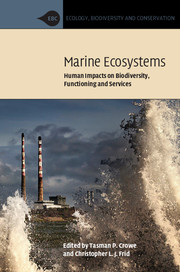Book contents
- Frontmatter
- Contents
- List of contributors
- Part I Key concepts
- Part II Impacts of human activities and pressures
- 6 Marine fisheries and aquaculture
- 7 Artificial physical structures
- 8 Eutrophication and hypoxia: impacts of nutrient and organic enrichment
- 9 Pollution: effects of chemical contaminants and debris
- 10 Invasions by non-indigenous species
- Part III Synthesis and conclusions
- Index
- Plate Section
- References
9 - Pollution: effects of chemical contaminants and debris
from Part II - Impacts of human activities and pressures
Published online by Cambridge University Press: 05 June 2015
- Frontmatter
- Contents
- List of contributors
- Part I Key concepts
- Part II Impacts of human activities and pressures
- 6 Marine fisheries and aquaculture
- 7 Artificial physical structures
- 8 Eutrophication and hypoxia: impacts of nutrient and organic enrichment
- 9 Pollution: effects of chemical contaminants and debris
- 10 Invasions by non-indigenous species
- Part III Synthesis and conclusions
- Index
- Plate Section
- References
Summary
Introduction
Coastal marine ecosystems are both diverse and productive (Suchanek, 1994; Gray, 1997). They are ecologically significant and socioeconomically important providing an array of critical services and benefits to humans (see Chapters 1 and 2). The delivery of services depends, however, on the efficient functioning of ecosystems, which in turn, is influenced by biological diversity. Marine ecosystems are subject to a range of threats that may affect both diversity and function. In coastal and estuarine systems, contaminants can be a major problem (Thompson et al., 2002). Pollution has been associated with reductions in the densities, biomass and number of species in marine systems (e.g. Johnston and Roberts, 2009) and reductions in ecosystem function (Breitburg et al., 1999; Gonzalez et al., 2009; Johnston et al., 2015; Mayer-Pinto et al., in review). Declining water quality and contamination have been identified as critical factors contributing to the degradation and loss of ecologically and economically important marine biogenic habitats, such as seagrass, kelp beds and coral reefs (see e.g. Benedetti-Cecchi et al., 2001; Duarte, 2002; Bellwood et al., 2004; Foster and Schiel, 2010). Understanding the effect of contaminants on both biodiversity and ecosystem function is critical if we are to effectively prioritise conservation actions and ensure the security of ecosystem services.
In this chapter we review the effects of chemical contaminants on the biological diversity and functioning of marine systems. Most researchers have studied contaminant effects on diversity or function independently and this review is the first to consider the two sets of studies together. By taking a holistic approach, we have been able to identify common patterns in the effects of contaminants and critical areas that require further study.
What are contaminants and where do they come from?
In its most generalised form, contamination is an increase in the concentration of any constituent in the water, soil, sediment and/or organism above the natural background level for that area or those organisms (Clark, 2001).
- Type
- Chapter
- Information
- Marine EcosystemsHuman Impacts on Biodiversity, Functioning and Services, pp. 244 - 273Publisher: Cambridge University PressPrint publication year: 2015
References
- 3
- Cited by



